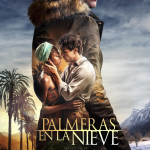
Eböobé people are part of the L haplogroup, which is the root gene, called the “”Mitochondrial Eve” gene. The map illustrates our migration journey from the Congo region/Central Africa to the north during the Bantu expansion, where we stopped in Cameroon. That is why many people who trace their DNA to these regions have haplogroup like: L1,L2,L1a…
According to a “Bubi” legend, amid the widespread war invasion across Africa, the Eböobé people, guided by a spirit named Eri, patiently waited on the outskirts of Cameroon for a signal from the spirit. The narrative recounts the emergence of a dark gray cloud from the sea, which turned out to be the eruption of Pico Basilé, giving rise to an island. Biátto (Canoes), crafted from sizable trees, were fashioned to transport families to this newfound land. Upon arrival, the island was named Ëtulá a Ëri. The Abóbë people sustained themselves with seafood and lush greens from the forest along with the favored yam, Taro. Isolated from the mainland, they successfully preserved their ancient culture and language.
Who Colonized Us?
Around 1472, Fernão do Pó also known as Fernão Pó, a 15th-century Portuguese navigator and explorer of the West African coast, was the to discover the bubi and make contact. Until the mid-1900s after trading with Spain, the island bore a variation of his name, either Fernando Pó or Fernando Poo. This historical connection marked Equatorial Guinea as the sole African country where Spanish is a primary language. It was during Bötói/Vönoá is a fertility rites ceremony in which young girls venture out to sea to gather water, purifying both themselves and the village. With the Spanish presence in the region, they were aware of this annual ritual that unfolded each May. Exploiting this knowledge, they strategically awaited the young girls on the verge of womanhood as they went to the sea to collect water, subsequently abducting them into the slave trade.
Appointed by France, Francisco Macías Nguema served as the inaugural President of Equatorial Guinea from 1968 until his ousting in 1979. He is widely remembered as one of the most brutal dictators in history. His rule ended on August 3, 1979, when he was overthrown by nephew, Teodoro Obiang Nguema Mbasogo. Unfortunately, Teodoro Nguema Obiang and the Obiang family are the world’s longest serving dictators. The Obiang family has amassed a fortune depleting Bioko Island of its precious oil and land. Equatorial Guinea is the richest country in Africa, yet people live in plastic-shack poverty.
Is a Hollywood romanticized version of Fernando Po’s conquest of Bioko Island and modern day time.
“Far far away, behind the word mountains, far from the countries Vokalia and Consonantia, there live the blind texts. Separated they live in Bookmarksgrove right at the coast of the Semantic”
Dr. Enrique Okenve
University of the West Indies at Mona, Jamaica
A Social History of Equatorial Guinea - African Scholars Series N°001 - Dr Enrique Okenve
Dr Enrique Okenve teaches African history at the University of the West Indies at Mona, Jamaica. He received his PhD from the School of Oriental and African Studies-University of London. His research interest focuses on socio-cultural transformations in colonial Central Africa, in particular Equatorial Guinea (EG).
He has recently completed an article on the transformation of genealogical memory among Fang-speaking peoples in mainland EG (forthcoming, Ayer) and a book chapter for an edited volume (forthcoming, African Islands: Leading Edges of Empire and Globalization). The latter deals with the marginalization of the Bubi people in relation to the location of the colonial capital on the island of Bioko.
7:25
What has changed in the past 10 years.
12:57
Current Projects
10:31
Political History
19:10
Academic Freedom
Life on Bioko Island
Click the buttons above to help support Wildlife protection!

